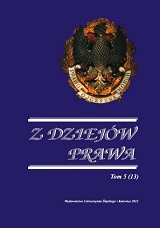Wpływ "bona fides" na odpowiedzialność sprzedawcy za wady towaru w prawie rzymskim
The influence of "bona fides" on the responsibility of the sender for defects of goods in the Roman law
Author(s): Karina ChodańSubject(s): Law, Constitution, Jurisprudence
Published by: Wydawnictwo Uniwersytetu Śląskiego
Summary/Abstract: The basis of the consensus buy-sell agreement was the bona fides of both parties. When making an agreement, both a buyer and seller were required to be careful because any manifestations of inadequacy and dishonesty grew a property liability of both parties. Client’s careless behavior could consist in a conscious action to the detriment of the partner (dolus), as well as negligence (neglegentia). Judges have referred to the term bona fides since the second century BC when evaluating the situation in which making an agreement was connected with dishonesty of one of the parties, and a conscious harm done to the second client, in order to justify the overruling of the client’s obligation, to signify such carefulness that reflects the scope of agreement liability typical in a given case. Each of such behaviours could be defined as incongruent with bona fides. Such adjudications were to serve the protection against damage resulting from agreement making, providing honesty of the turnover via increasing the scope of liability and excluding the advantage of the one making an agreement conscious of doing harm to the client. The process of charging the seller with liability irrespective of his/her good or bad intentions if provided the buyer with defective goods the existence of which the buyer was not aware of has been traced since Justinian’s times. Taking into account the role of bona fides when evaluating a buying-selling agreement and principles concerning seller liability one can make a statement that bona fides played a Basic role in a Roman emptio — venditio agrement.
Journal: Z Dziejów Prawa
- Issue Year: 13/2012
- Issue No: 5
- Page Range: 17-30
- Page Count: 14
- Language: Polish

